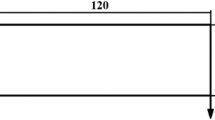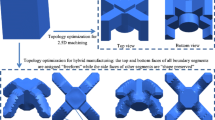Abstract
In industrial practice, additive manufacturing (AM) processes are often followed by post-processing operations such as heat treatment, subtractive machining, milling, etc., to achieve the desired surface quality and dimensional accuracy. Hence, a given part must be 3D-printed with extra material to enable this finishing phase. This combined additive/subtractive technique can be optimized to reduce manufacturing costs by saving printing time and reducing material and energy usage. In this work, a numerical methodology based on parametric shape optimization is proposed for optimizing the thickness of the extra material, allowing for minimal machining operations while ensuring the finishing requirements. Moreover, the proposed approach is complemented by a novel algorithm for generating inner structures to reduce the part distortion and its weight. The computational effort induced by classical constrained optimization methods is alleviated by replacing both the objective and constraint functions by their sparse grid surrogates. Numerical results showcase the effectiveness of the proposed approach.






Similar content being viewed by others
References
J. Nocedal and S. Wright, Numerical Optimization, 1st ed. (New York: Springer, 1999).
G. Allaire, F. Jouve, and A. Toader, J. Comput. Phys. 194, 363 (2004).
E. Picelli, S. Townsend, C. Brampton, J. Norato, and A. Kim, Comput. Methods Appl Mech. Eng. 329, 1 (2018).
Y. Wang and Z. Kang, Comput. Methods Appl Mech. Eng. 329, 553 (2018).
C. Dapogny, R. Estevez, A. Faure, and G. Michailidis, Comput. Methods Appl Mech. Eng. 344, 626 (2019).
F. Zwicke, M. Behr, and S. Elgeti, AIP Conf. Proc. 1896, 100001 (2017).
G. Allaire, C. Dapogny, R. Estevez, A. Faure, and G. Michailidis, J. Comput. Phys. 351, 295 (2017).
S. Cacace, E. Cristiani, and L. Rocchi, Appl. Math. Model. 44, 446 (2017).
M. Chiumenti, E. Neiva, E. Salsi, M. Cervera, S. Baida, J. Moya, Z. Chen, C. Lee, and C. Davies, Addit. Manuf. 18, 171 (2017).
E. Neiva, S. Badia, A.F. Martin, and M. Chiumenti, Int. J. Numer. Methods Eng. 119, 1098 (2019).
H.-J. Bungartz and M. Griebel, Acta Numer. 13, 147 (2004).
F. Nobile, L. Tamellini, and R. Tempone, Numer. Math. 134, 343 (2016).
C. Altenhofen, M. Attene, O. Barrowclough, M. Chiumenti, M. Livesu, F. Marini, M. Martinelli, V. Skytt and L. Tamellini, Parametric shape optimization for combined additive-subtractive manufacturing,” (arXiv preprints, 2019). https://arxiv.org/abs/1907.01370. Accessed Oct. 2, 2019.
M. McKay, R. Beckman, and W. Conover, Technometrics 21, 239 (1979).
M. Buhmann, Radial Basis Functions: Theory and Implementations, 1st ed. (Cambridge: Cambridge University Press, 2003).
F. Ballarin, A. Manzoni, A. Quarteroni, and G. Rozza, Int. J. Numer. Methods Eng. 102, 1136 (2014).
C. Higham and D. Higham, Deep Learning: An Introduction for Applied Mathematicians (arXiv preprints, 2018). https://arxiv.org/abs/1801.05894. Accessed Oct. 2, 2019.
J. Valentin and D. Pflüger, Hierarchical Gradient-Based Optimization with B-Splines on Sparse Grids, Sparse Grids and Applications—Stuttgart 2014, ed. J. Garcke, D. Pflüger (Springer 2016), p. 315.
E. Catmull and J. Clark, Comput. Aided Des. 10, 350 (1978).
A. Fabri, M. Teillaud, CGAL, The Computational Geometry Algorithms Library (10ème Colloque National en Calcul des Structures, 2011), https://hal.archives-ouvertes.fr/CSMA2011/hal-00592685v1. Accessed Oct. 2, 2019.
P.K.L. Hachenberger, L. Kettner, and K. Mehlhorn, Comput. Geom 38, 64 (2007).
R.Y.M. Laurent, Comput. Geom. Theory Appl. 38, 100 (2007).
M. Chiumenti, X. Lin, M. Cervera, W. Lei, Y. Zheng, and W. Huang, Rapid Prototyp. J. 23, 448 (2017).
E. Neiva, M. Chiumenti, M. Cervera, E. Salsi, G. Piscopo, S. Badia, A. Martin, Z. Chen, C. Lee and C. Davies, Numerical modelling of heat transfer and experimental validation in Powder-Bed Fusion with the Virtual Domain Approximation (arXiv preprints, 2018). https://arxiv.org/abs/1811.12372v4. Accessed Oct.2, 2019.
I. Setien, M. Chiumenti, S. van der Veen, M. San Sebastian, F. Garciandía, and A. Echeverría, Comput. Math. Appl. 78, 2282 (2019).
M. Cervera, C. Agelet de Saracibar and M. Chiumenti, COMET: Coupled Mechanical and Thermal Analysis. Data Input Manual, Version 5.0 (CIMNE technical report IT-308, 2002). https://www.cimne.com/comet/cvdata/cntr1/dtos/mdia/COMET_Data_Input_manual.pdf. Accessed Oct. 2, 2019.
CIMNE, Technical University of Catalonia, GiD: the Personal Pre and Post-Processor (2002). http://gid.cimne.upc.edu. Accessed Oct. 2, 2019.
P.J. Besl and N.D. McKay, IEEE Trans. Pattern Anal. Mach. Intell. 14, 239 (1992).
Docker Inc., Docker. www.docker.com. Accessed Oct. 2, 2019.
The SG++ Project, SG++ (2008). http://sgpp.sparsegrids.org. Accessed Oct. 2, 2019.
The CGAL Project, CGAL (1995). www.cgal.org. Accessed Oct. 2, 2019.
SINTEF Digital, GoTools: Geometry Toolkit. https://github.com/SINTEF-Geometry/GoTools (2018). Accessed Oct. 2, 2019.
Acknowledgements
This work was funded by the European Union’s Horizon 2020 research and innovation program under Grant Agreement No. 680,448 CAxMan, Computer-Aided technologies for Additive Manufacturing.
Author information
Authors and Affiliations
Corresponding author
Additional information
Publisher's Note
Springer Nature remains neutral with regard to jurisdictional claims in published maps and institutional affiliations.
Rights and permissions
About this article
Cite this article
Tamellini, L., Chiumenti, M., Altenhofen, C. et al. Parametric Shape Optimization for Combined Additive–Subtractive Manufacturing. JOM 72, 448–457 (2020). https://doi.org/10.1007/s11837-019-03886-x
Received:
Accepted:
Published:
Issue Date:
DOI: https://doi.org/10.1007/s11837-019-03886-x




